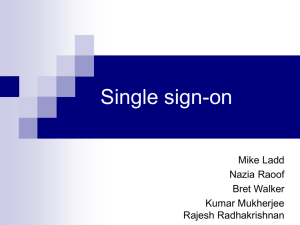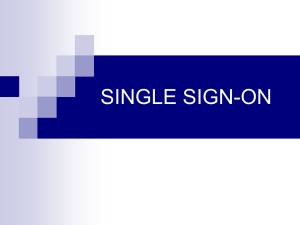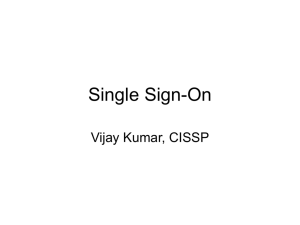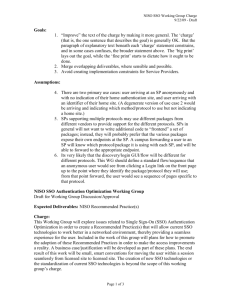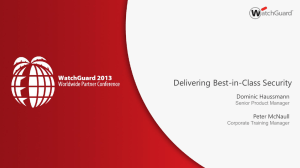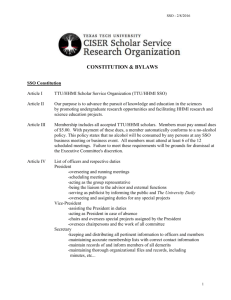Authentication Systems, Single-Sign-On (SSO)
advertisement
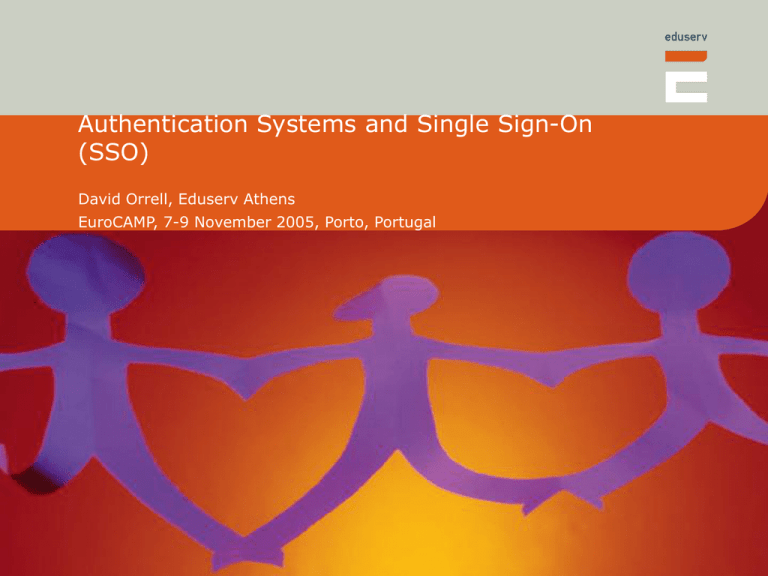
Authentication Systems and Single Sign-On (SSO) David Orrell, Eduserv Athens EuroCAMP, 7-9 November 2005, Porto, Portugal Overview • What is SSO? • How SSO operates • Implications of SSO • SSO products and authentication systems • SSO real-world examples and applications Why SSO? • Multiple systems typically require multiple sign-on dialogues – Eg. Desktop logon, email, VLE, library systems, external resources … – Multiple sets of credentials – Presenting credentials multiple times • Headache for administration and users • The more security domains, the more sign-ons required Simple SSO operation Authentication Domain Secondary domain 1. Access application 2. Refer for authn. 3. Ask for credentials SSO Application Application /resource 4. Transfer to application Application /resource SSO Session (Ticket Granting Ticket) Transfer/Service ticket Secondary domain Security implications • Credentials never leave the authentication domain • Secondary (affiliated) domains have to trust the authentication domain – Credentials must be asserted correctly – Protect from unauthorised use • Authentication transfer has to be protected – Replay prevention – Interception/masquerade attacks SSO Components Sign-on (verification) App (enforcement) HTTP server Application SSO Application Enforcement agent Authorisation • LDAP Authentication server • Kerberos • RDBMS • … SSO dependencies • SSO system relies on other infrastructure – Authentication system – Requires interface with web server – Identity management/registration • Need to provide for authorisation – Applications often need more than just authentication information – Attribute information – Shibboleth or other architectures Other considerations • Most SSO systems are HTTP based – Browser cookies (restricted to the authentication domain) – HTTP redirects – Placement of tokens in querystring • May require integration with application – Agent-based architecture – SSO protocol • Needs to interface with authentication system • Needs protocol between authentication domain and target application – Token/ticket-based – SAML POST/artifact profiles Session management • The SSO application maintains a session (TGT) for the user • The target application usually maintains a session • Logging out of the target application may not log you out of the SSO application • Single Sign-On Single Sign-Out! – Application specific Single Sign-On applications • Cross-institutional SSO – Athens (Eduserv/UK) – PAPI (Rediris/Spain) – Shibboleth (Internet2/USA) • Commercial SSO products – Often companion products to identity managers/directories – Increasing standards compliance (SAML etc.) – Eg. Novell iChain, Sun Java System Access Manager etc… • Others – VLE, portal and library management products often have SSO capability WebISO products (1) • “Web initial sign-on” products available for intra-institutional use – Allow authentication to web-based resources across an institution • Freely available – Many released under Open Source licences • Comparison study carried out for JISC, UK – Recommended reading http://www.jisc.ac.uk/uploaded_documents/CMSS-Gilmore.pdf WebISO products (2) • Yale Central Authentication Service (CAS) – http://www.yale.edu/tp/auth • Pubcookie (Washington) – http://www.pubcookie.org • WebAuth (Stanford) – http://webauthv3.stanford.edu • Michigan CoSign – http://www.umich.edu/~umweb/software/cosign • X.509 certificates via Kerberos (Michigan) – http://www.umich.edu/~x509 • A-Select (Surfnet) – http://a-select.surfnet.nl SSO methods • Most SSO systems rely on cookies – Widely accepted and supported by browsers – Users who disable cookies or change browser security settings may lose SSO capability • X.509 certificates provide alternative approach – Require installation on users machine – Need for revocation – Can be confusing for users Supported Authentication Methods • CAS – LDAP server (OpenLDAP, Active Directory) – Kerberos (MIT, Active Directory) • Pubcookie – Kerberos v5 – LDAP server – /etc/shadow • WebAuth – MIT Kerberos – OpenLDAP • CoSign – Supports GSSAPI • A-Select – Banking – SMS ‘SURFkey’ – LDAP – Radius overview overview Authentication in A-Select choose your own method (and strength) • • IP address Username / password – LDAP / Active Directory – RADIUS – SQL • • • • • • Passfaces PKI certificate OTP through SMS OTP through internet banking Tokens (SecurID, Vasco, …) Biometrics Choosing an SSO system (1) • Need to evaluate systems appropriate to your environment – Apache/IIS/J2EE – OS/platform support • Will the SSO product integrate with my – authentication system – applications (agent/webserver integration, legacy applications) – authorisation system (Shibboleth support?) • Need to provide resilient system – Single point of failure – Performance/throughput Choosing an SSO system (2) • Need to be supportable – Is the product actively developed? – What is the support like? – Logging/diagnostics – Error handling • Customisable – Some SSO products are specific to the organisation they originated from. Can it be customised for your needs? SSO applications • Applications typically require an ‘enforcement agent’ – Webserver module – Application-level integration – Usually require authorisation info • Some SSO products utilise a proxy approach – SSO-enable legacy products without code change – Eg. Novell iChain SSO in portals SSO in portals Other SSO services Other SSO services Other SSO services Other SSO services Logout • QUESTIONS? david.orrell@eduserv.org.uk http://www.eduserv.org.uk/athens
